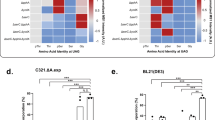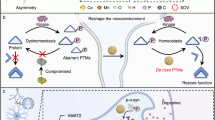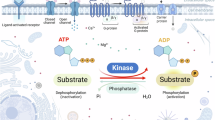Abstract
NEUROTRANSMITTERS can modulate neuronal activity through a variety of second messengers that act on ion channels and other substrate proteins1–3. The most commonly described effector mechanism for second messengers in neurons depends on protein phosphorylation mediated by one of three sets of kinases: the cyclic AMP-dependent protein kinases4,5, the Ca2+–calmodulin-dependent protein kinases3,6, and the Ca2+–phospholipid-dependent protein kinases7. In addition, some neurotransmitters and second messengers can also inhibit protein phosphorylation by lowering cAMP levels (either by inhibiting adenylyl cyclase8 or activating phosphodiesterases9). This raises the question: can neurotransmitters also modulate neuronal activity by decreasing protein phosphorylation that is independent of cAMP? Various biochemical experiments show that a decrease in protein phosphorylation can arise through activation of a phosphatase10,11 or inhibition of kinases12,13. In none of these cases, however, is the physiological role for the decrease in protein phosphorylation known. Here we report that in Aplysia sensory neurons, the presynaptic inhibitory transmitter FMRFamide decreases the resting levels of protein phosphorylation without altering the level of cAMP. Furthermore, FMRFamide overrides the cAMP-mediated enhancement of transmitter release produced by 5-hydroxytryptamine (5-HT), and concomitantly reverses the cAMP-dependent increase in protein phosphorylation produced by 5-HT. These findings indicate that a receptor-mediated decrease in protein phosphorylation may play an important part in the modulation of neurotransmitter release.
This is a preview of subscription content, access via your institution
Access options
Subscribe to this journal
Receive 51 print issues and online access
$199.00 per year
only $3.90 per issue
Buy this article
- Purchase on SpringerLink
- Instant access to full article PDF
Prices may be subject to local taxes which are calculated during checkout
Similar content being viewed by others
References
Kaczmarek, L. K. & Levitan, I. B. (eds) Neuromodutation (Oxford University Press, New York, 1987).
Nestler, E. J. & Greengard, P. Protein Phosphorylation in the Nervous System (Wiley, New York, 1984).
Siegelbaum, S. A. & Tsien, R. W. Trends Neurosci. 6, 307–313 (1983).
Levitan, I. J. Membrane Biol. 87, 177–190 (1985)
Kuo, J. F. & Greengard, P. Proc. natn. Acad. Sci. U.S.A. 64, 1349–1355 (1969).
Kennedy, M. B., Bennett, M. K. & Erondu, N. E. Proc. natn. Acad. Sci. U.S.A. 80, 7357–7361 (1983).
Nishizuka, Y. Science 233, 305–312 (1986).
Gilman, A. G. Cell 36, 577–579 (1984).
Hughes, A. R., Martin, M. W. & Harden, T. K. Proc. natn. Acad. Sci. U.S.A. 81, 5680–5684 (1984).
Stewart, A. A., Ingebritsen, T. S., Manalan, A., Klee, C. B. & Cohen, P. FEBS Lett. 137L, 80–84 (1982).
Hemmings, H. C., Greengard, P., Tung, H. Y. L. & Cohen, P. Nature 310, 503–504 (1984).
Walsh, D. A., Perkins, J. P. & Krebs, E. G. J. biol. Chem. 243, 3763–3774 (1968).
Walsh, D. A. et al. J. biol. Chem. 246, 1977–1985 (1971).
Siegelbaum, S. A., Camardo, J. S. & Kandel, E. R. Nature 299, 413–417 (1982).
Belardetti, F., Kandel, E. R. & Siegelbaum, S. A. Nature 325, 153–156 (1987).
Kandel, E. R. & Schwartz, J. H. Science 218, 433–443 (1982).
Piomelli, D. et al. Nature 328, 38–43 (1987).
Bernier, L., Castellucci, V. F., Kandel, E. R. & Schwartz, J. H. J. Neurosci. 2, 1682–1691 (1983).
Occorr, K. A. & Byrne, J. H. Neurosci. Lett. 55, 113–118 (1985).
Sweatt, J. D. & Kandel, E. R. Nature 339, 51–54 (1989).
Belardetti, F. et al. Neuron (in the press).
Ingebritsen, T. S. & Cohen, P. Science 221, 331–338 (1985).
Limbird, L. E. & Sweatt, J. D. in The Receptors ed. P. M. Conn 281–301 (Academic, New York, 1985).
Kato, R. & Nakaki, T. 1983. Trends pharmacol. Sci. 4, 34–36 (1983).
Limbird, L. E. Fedn Proc. 2, 2686–2695 (1988).
Simms, S. M., Singer, J. J. & Walsh, J. V. Science 239, 190–193 (1988).
Nakaki, T., Kakadate, T., Yamamoto, S. & Kato, R. Life Sci. 32, 191–195 (1983).
Buttner, N., Siegelbaum, S. A. & Volterra, A. Nature (in the press).
Author information
Authors and Affiliations
Rights and permissions
About this article
Cite this article
Sweatt, J., Volterra, A., Edmonds, B. et al. FMRFamide reverses protein phosphorylation produced by 5-HT and cAMP in Aplysia sensory neurons. Nature 342, 275–278 (1989). https://doi.org/10.1038/342275a0
Received:
Accepted:
Issue date:
DOI: https://doi.org/10.1038/342275a0
This article is cited by
-
The neuronal background K2P channels: focus on TREK1
Nature Reviews Neuroscience (2007)
-
Inhibition of a slowly inactivating high-voltage-activated calcium current by the neuropeptide FMRFa in molluscan neuroendocrine cells
Invertebrate Neuroscience (1995)
-
The regulation and function of protein phosphatases in the brain
Molecular Neurobiology (1991)
-
Direct modulation of Aplysia S-K+ channels by a 12-lipoxygenase metabolite of arachidonic acid
Nature (1989)



